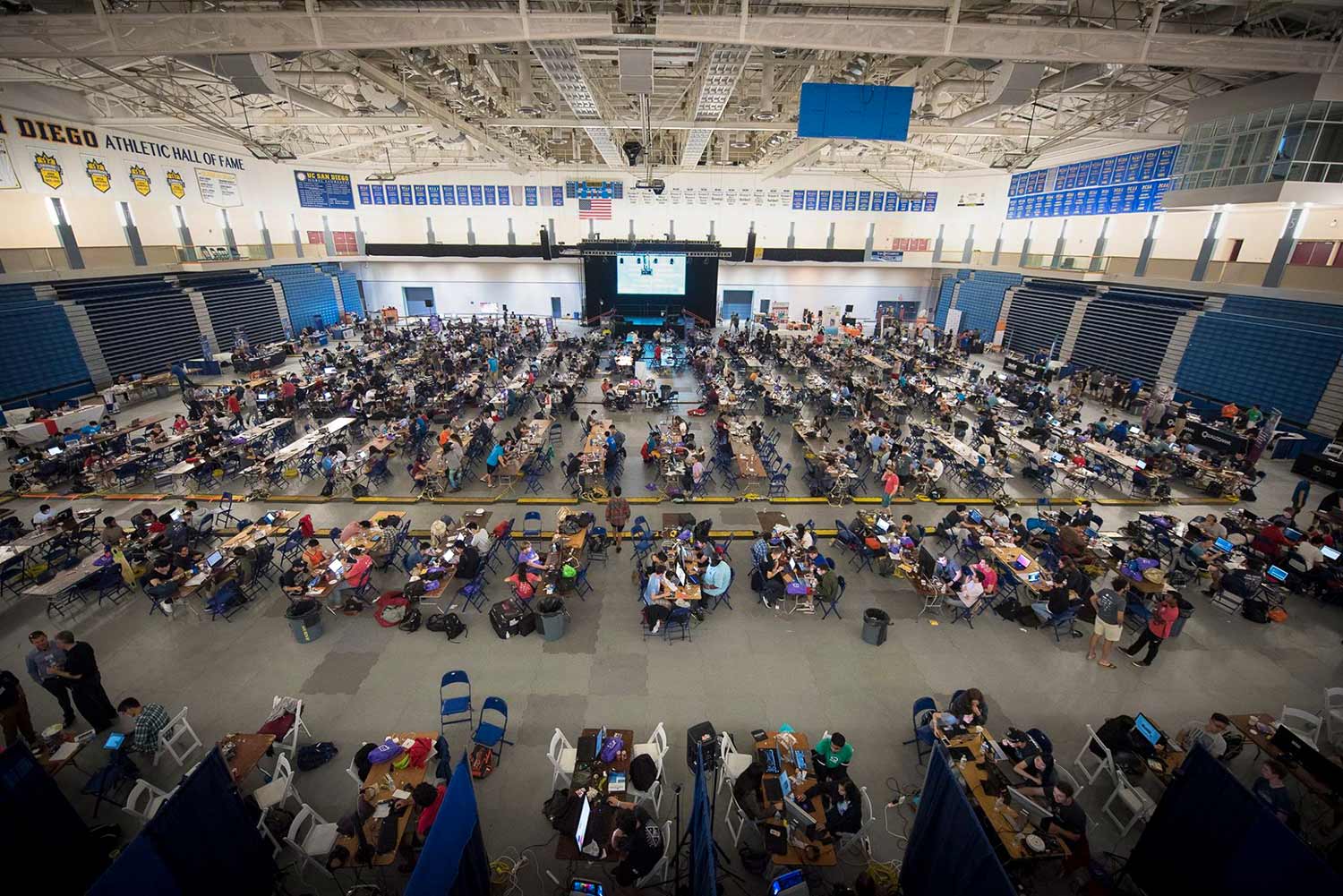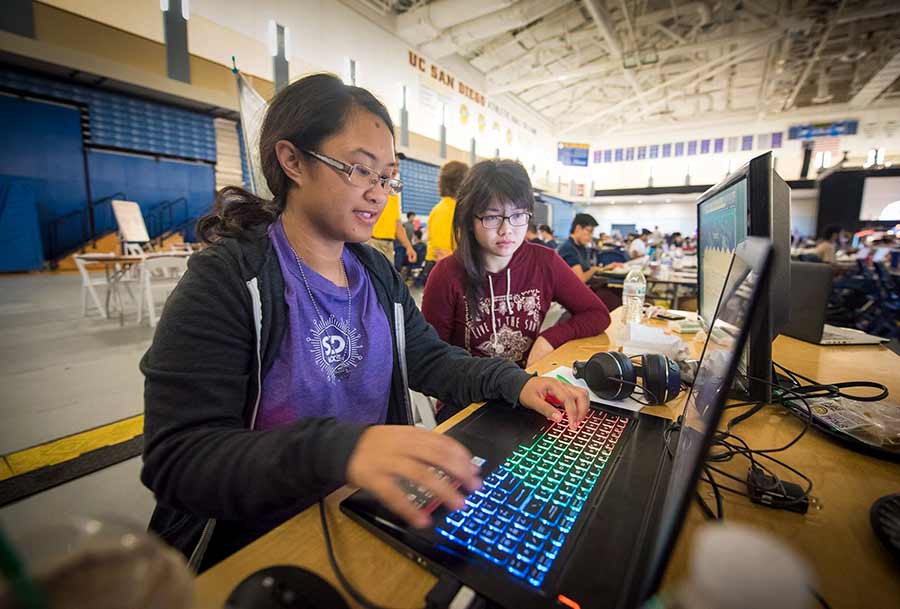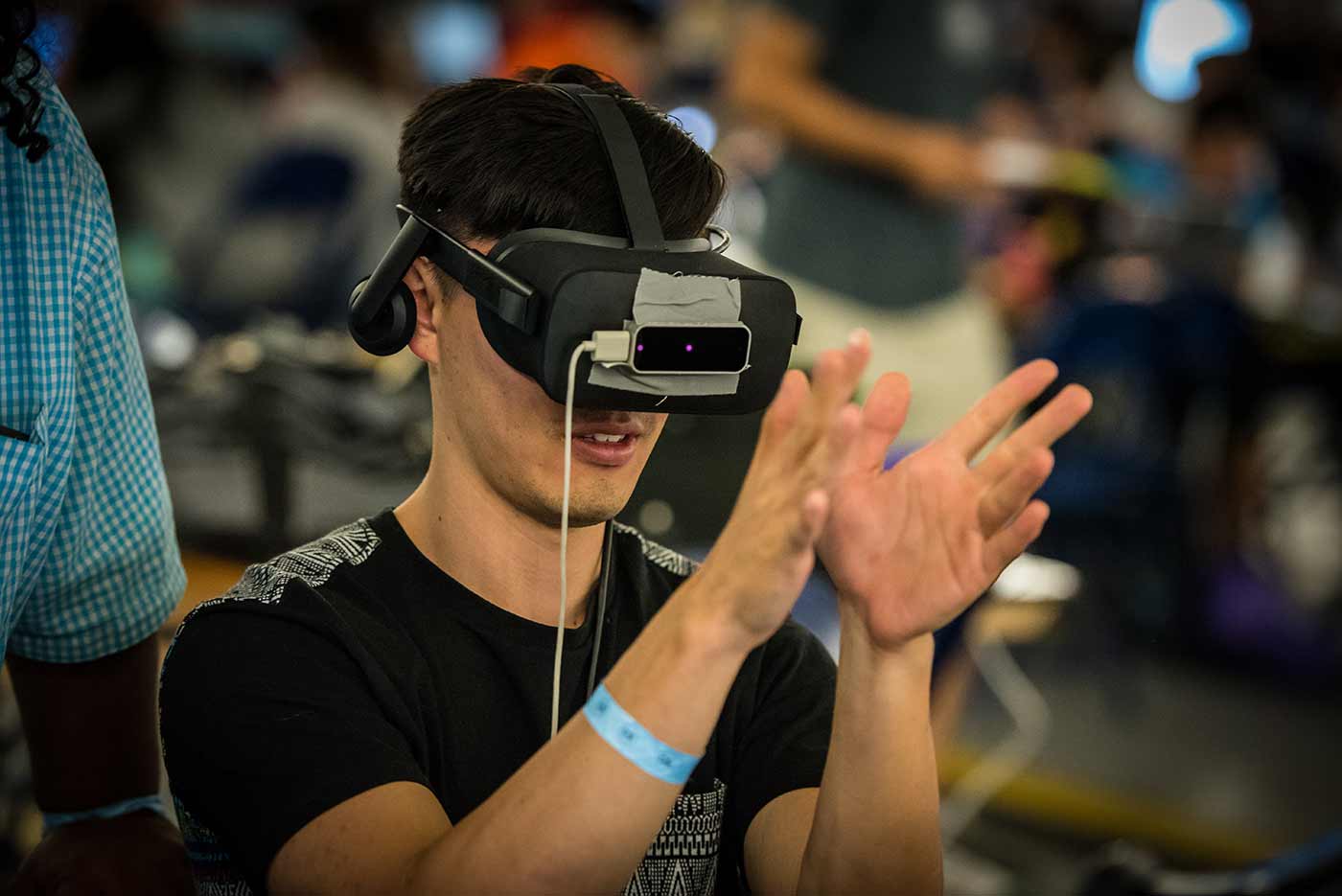
By:
- Deborah Osae-Oppong
Published Date
By:
- Deborah Osae-Oppong
Share This:

Photo by Alex Matthews/Qualcomm Institute
Coding Under Pressure: Students Prototype Ideas in 36-Hour Hackathon
Hackathons help you learn to put ideas and technologies together just enough to get your point across and convince others that your idea is worth investing in.
This nugget is from computer science alumna Sarah Guthals (Computer Science B.S. ’10, M.S. ’12, Ph.D. ’14), a co-founder of the computer science education company ThoughtSTEM and co-author of Minecraft Modding for Kids, which is part of the “for Dummies” book series. Guthals was speaking at SD Hacks last weekend, a massive technology innovation and networking event that took place on campus. Close to 1,000 students from around campus and the country gathered to share ideas, network with companies and take technological inventions from start to finish. Students had 36 hours to invent, build and iterate on their hack. The student-run event is one of the largest student hackathons in Southern California, and 2016 was just the second year for SD Hacks. The event was launched, and is run, by a group of dedicated students who decided to put UC San Diego and the region’s innovation ecosystem on the map with SD Hacks.
“We had 3,000 applications in 2015,” said Yacoub Oulad Daoud, a third-year computer science major at UC San Diego and one of the students heading up the event. “This year, we had over 4,000 applications.”
Some of the students came in with a clear idea of the projects they wanted to pursue while others came with a much more open-ended plan for the 36 hours of intense work, interspersed with video games, guitars and maybe even a bit of shut eye in sleeping bags.
"I came to SD Hacks to work on a personal project,” said Andres Gomez, a fourth-year computer engineering major at UC San Diego. “I wanted to create a mobile app to inform incoming freshmen of all the majors available at UC San Diego,” including the skills students acquired in different majors and the industries they will most likely get hired into.
Danny Peng and Amin Fozi, both third-year math majors from UC San Diego, came into the weekend knowing they wanted to build an app that had to do with disaster preparedness.
“We live in California, where we’re so susceptible to natural disasters, but how many of us are actually ready for one?” said Fozi. “We want to bring preparedness up to date. We all have a phone—the app will enable you to assign a rendezvous location, and tell you which items to bring.”

Photo by Alex Matthews/Qualcomm Institute
Let the hacking begin
The event kicked off with opening ceremonies on Friday evening. Among the keynote speakers was Sarah Guthals, who encouraged students to consider the many career paths that computer science offers. “There are many ways you can use [computer science] to contribute to our world. That doesn’t just mean working for a software company.”
Another of the keynote speakers, Danielle Strachman, founder of venture capital fund 1517, said, “You’re lucky, and I’m jealous. What you’re going to do in the 36 hours that you’re here would’ve taken weeks for someone in my day to build. We didn’t have microcontrollers that came out of a box, or rapid prototyping tools.”
One of the projects that made use of the rapid prototyping tools is Scriply, a 3D-printed pill dispenser connected to a microcontroller and database that keeps track of prescription drug use. The Scriply team took the prizes for Best Design, Best Hardware Hack, Best use of Arduino presented by General Atomics and Best Internet of Things Hack presented by Qualcomm Institute. The team was made up of students from UC Merced, UC Santa Cruz and UC San Diego.
“We knew each other at UC Merced,” said Hoaithi Dang, who just transferred to UC San Diego for math. “In fact, the four of us went backpacking through Asia together this summer.”
“We started brainstorming on Friday night,” said Jacqueline Clow, a robotics engineering major at UC Santa Cruz. “We thought about what user we wanted to target, and what their problems might be. We decided to create an app that could help families manage their prescriptions.”
“I learned how to structure a business through this experience,” said Sohpie Vo, a UC Merced management and business economics major. “We had someone involved in every aspect of the hack.”
The team that won overall Best of Show title was Re:Art, an app similar to Prisma—but for video. The team is comprised of UC San Diego sophomore computer science majors Chen Yang, Zhuojun Chen, Wanze Xie and Jianhan Xu. The Office of Innovation and Commercialization at UC San Diego also awarded them $1,000 for the best commercial solution.
“This was a great experience,” said Yang. “In addition to building a great product, I mastered Python.”
While only some of the teams won prizes, all 100 of the teams that submitted hacks left the event with a new project and new leadership, teamwork and technical skills to add to their portfolio.
Students and future employers connect
Resembling a career fair, sponsor tables lined the crowded arena—from Qualcomm and Viasat to the National Security Agency. The onsite companies offered technical assistance, prizes, interview opportunities and more.
Many of the sponsors gave students the opportunity to inspire and impress them with their creativity by offering prizes for hacks relating to their company’s focus area. Qualcomm brought their Dragon board, hosted a workshop, and gave one away to the team that demonstrated the best use of the board; ViaSat offered first, second and third cash prizes for an app that connects people; Twitch challenged students to create a chatbot that could generate fun content; and SPAWAR awarded job interviews to three teams.
An organizer offered an iOS workshop and introduced students to Swift—Apple’s programming language for building apps.

Photo by Alex Matthews/Qualcomm Institute
The Virtual Reality Club provided a space for virtual reality development (VR) featuring HTC Vive and Oculus Rift headsets, high performance computers and mentors both from the Virtual Reality Club and NanoVR, a UC San Diego startup. In addition, Innovate Club provided a “maker space” with 3D printing and modeling support to students with hardware hacks.
About SD Hacks
A wide variety of companies and organizations across the region, and many groups at UC San Diego came together to sponsor and support SD Hacks. Campus partners included the Jacobs School of Engineering, the Department of Computer Science and Engineering, the Office of Innovation and Commercialization, UC San Diego Alumni, the Qualcomm Institute, and the Rady School of Management.
The event is a member of Major League Hacking (MLH), the official student hackathon league. Each year, MLH supports over 200 weekend-long invention competitions to promote innovation and teach computer science skills to college students around the world.
“We support SD Hacks because the world is better if there are more engineers and the engineers are better at what they do,” said Nik Deveraux, engineering manager at ViaSat and UC San Diego alumnus.
Share This:
You May Also Like
Stay in the Know
Keep up with all the latest from UC San Diego. Subscribe to the newsletter today.


